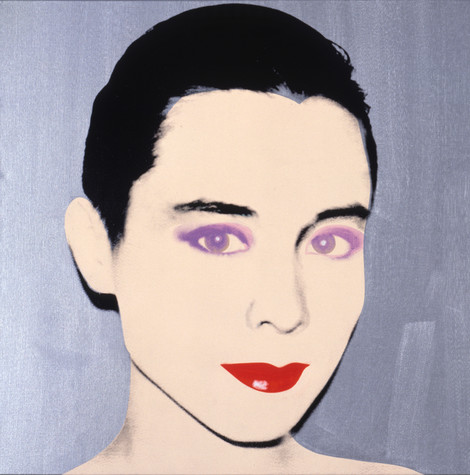The following assessments can be used for this lesson using the downloadable assessment rubric.
- Aesthetics 2
- Aesthetics 3
- Creative process 3
- Creative process 4
- Creative process 5
- Critical thinking 1
- Critical thinking 2

Andy Warhol, Tina Chow, 1985
The Andy Warhol Museum, Pittsburgh; Founding Collection, Contribution The Andy Warhol Foundation for the Visual Arts, Inc.
© The Andy Warhol Foundation for the Visual Arts, Inc.
1998.1.521
Warhol started painting commissioned portraits in the early 1960s. These works developed into a significant aspect of his career and were a main source of his income in the 1970s. Many of his subjects were well known in international social circles, the art world, and the entertainment industry at the time.
Warhol began each commissioned portrait with a photo shoot using a Polaroid camera. The Polaroid afforded a very high contrast image that Warhol enlarged and transferred onto a silkscreen. Each portrait was “under-painted” first. Warhol traced simple outlines of the photographic image onto the canvas and painted in blocks of color. Some portraits were painted in slick, hard-edge styles, whereas others had solid fields of color or more gestural brushwork. Once this initial painted layer was dry, Warhol printed the photographic silkscreen image on top.
I think eventually people competed to be portrayed by Warhol because that appeared to give them instant immortality, of the sort usually enjoyed only by the greatest of stars or the most celebrated products, as if they were also part of the common consciousness of the time.
Arthur C. Danto, The Nation, April 3, 1989
If there were a portrait commission, we’d have a lunch. It was fun and helped to relax people who were nervous about having their portrait done . . . You never knew who was going to be at lunch. You could have a pop star, if it was somebody very famous, we wouldn’t say that they were coming, we would tone down the lunch. I heard later that people were a little intimidated about coming to lunch . . . We had impromptu things happen, like when Georgia O’Keeffe came to get her portrait, I was videotaping Paloma Picasso and John Richardson, so by chance I also taped Georgia O’Keeffe and Paloma talking about Paloma’s father. Once I was taping a lunch, and Rupert brought John Lennon in while Andy was photographing Liza Minelli. Not every day at 860 was exciting, but you had many times where great people came in that you wouldn’t normally have a chance to really talk to. Andy was the whole reason for it being such a center of energy.
Vincent Fremont, One Stop Warhol Shop, 2000
In a class critique, students present their artwork and answer the following questions:
The following assessments can be used for this lesson using the downloadable assessment rubric.